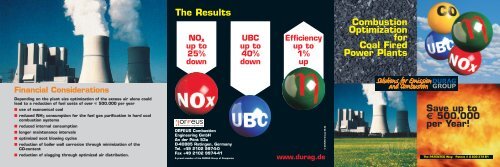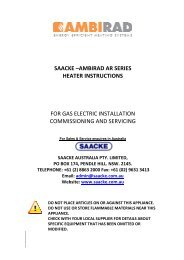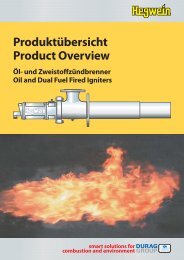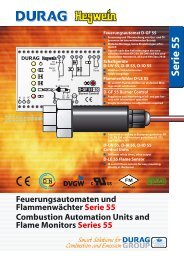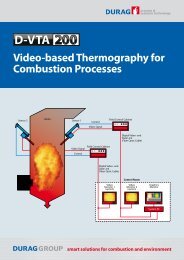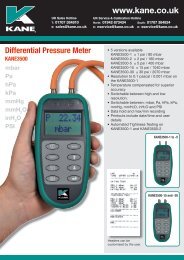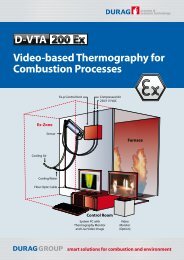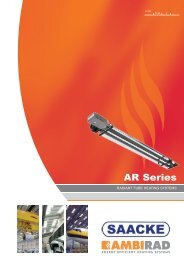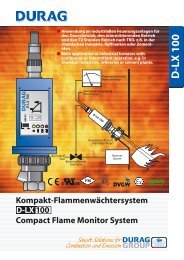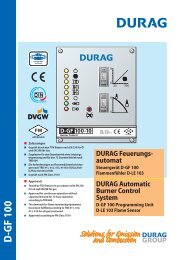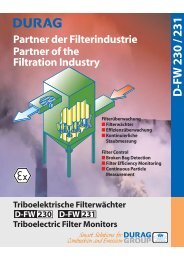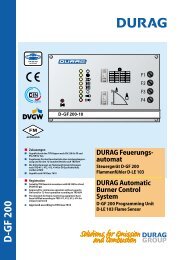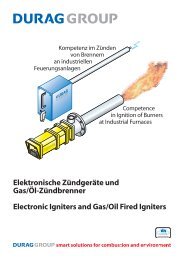Combustion Optimization for Coal Fired Power Plants Save up to ...
Combustion Optimization for Coal Fired Power Plants Save up to ...
Combustion Optimization for Coal Fired Power Plants Save up to ...
You also want an ePaper? Increase the reach of your titles
YUMPU automatically turns print PDFs into web optimized ePapers that Google loves.
The Results<br />
NO x<br />
<strong>up</strong> <strong>to</strong><br />
25%<br />
down<br />
UBC<br />
<strong>up</strong> <strong>to</strong><br />
40%<br />
down<br />
Efficiency<br />
<strong>up</strong> <strong>to</strong><br />
1%<br />
<strong>up</strong><br />
<strong>Combustion</strong><br />
<strong>Optimization</strong><br />
<strong>for</strong><br />
<strong>Coal</strong> <strong>Fired</strong><br />
<strong>Power</strong> <strong>Plants</strong><br />
Financial Considerations<br />
Depending on the plant size optimization of the excess air alone could<br />
lead <strong>to</strong> a reduction of fuel costs of over € 500.000 per year<br />
■ use of economical coal<br />
■ reduced NH 3 consumption <strong>for</strong> the fuel gas purification in hard coal<br />
combustion systems<br />
■ reduced internal consumption<br />
■ longer maintenance intervals<br />
■ optimized soot blowing cycles<br />
■ reduction of boiler wall corrosion through minimization of the<br />
CO-content<br />
■ reduction of slagging through optimized air distribution.<br />
ORFEUS <strong>Combustion</strong><br />
Engineering GmbH<br />
An der Pönt 53a<br />
D-40885 Ratingen, Germany<br />
Tel. +49 2102 9974-0<br />
Fax +49 2102 9974-41<br />
A proud member of the DURAG Gro<strong>up</strong> of Companies<br />
www.durag.de<br />
© DURAG Gro<strong>up</strong> 06.02<br />
<strong>Save</strong> <strong>up</strong> <strong>to</strong><br />
€ 500.000<br />
per Year!<br />
The PATENTED Way: Patent # 0 802 372 B1
Why ORFEUS <strong>Combustion</strong> <strong>Optimization</strong><br />
■ There is increasing competitive pressure on power plant opera<strong>to</strong>rs <strong>to</strong><br />
improve their plants’ economic efficiency.<br />
■ The conventional way of viewing the combustion chamber does not provide<br />
the data needed <strong>for</strong> a burner specific optimizing strategy.<br />
■ The ORFEUS view on individual flames bears the highest possible degree<br />
of in<strong>for</strong>mation such as the air/fuel ratio, changing coal qualities,<br />
clogging and pollution, tilted flames etc.<br />
■ Modern sensor technology, combined with advanced optimizing software<br />
is implemented in<strong>to</strong> an online control system.<br />
Non-optimal <strong>Combustion</strong><br />
The following fac<strong>to</strong>rs lead <strong>to</strong> a change in the fuel/air ratio on<br />
the burner and consequently <strong>to</strong> non-optimal<br />
combustion:<br />
■ coal transport problems in the system<br />
■ coal mill problems<br />
■ variing coal quality<br />
■ unfavourable distribution of coal<br />
dust in the system<br />
■ ignition problems.<br />
The ORFEUS System<br />
Based on the online analysis of the combustion process the ORFEUS<br />
<strong>Optimization</strong> System develops an optimization strategy with an emphasis on<br />
■ efficiency improvement<br />
■ emission reduction<br />
■ minimization of material stress<br />
A combination of the following components is used<br />
■ video moni<strong>to</strong>ring with image processing<br />
■ optional online spectroscopy<br />
■ optimizing software based on an artificial<br />
neural network (ANN), fuzzy-logic and classic<br />
modelling.<br />
The Strategy<br />
The diagram on the right<br />
shows the result of the<br />
optimization strategy<br />
„efficiency increase of the<br />
combustion process“<br />
whilst fulfilling the specifications<br />
- primary NO x is<br />
always <strong>to</strong> be minimized,<br />
CO is not <strong>to</strong> transgress a<br />
fixed limit and the <strong>to</strong>tal<br />
air quantity is <strong>to</strong> be minimized<br />
as well.<br />
Practical Examples<br />
Reduction of O 2 level<br />
in the flue gas<br />
CO content<br />
in the flue gas<br />
Reduction of NO x<br />
in the flue gas<br />
Load


